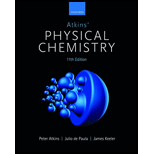
Interpretation:
The rate constant for the activation step in the mechanism has to be calculated.
Answer to Problem 17F.1ST
The rate constant for the activation step in the mechanism was
Explanation of Solution
Effective rate constant (Lindemann-Hinshelwood mechanism):
Given data is as follows:
By substituting the given value into the equation (1) as follows,
Therefore, the rate constant for the activation step in the mechanism was
Want to see more full solutions like this?
Chapter 17 Solutions
Atkins' Physical Chemistry
- 4) A typical bottle of pop holds carbon dioxide at a pressure of 5 atm. What is the concentration of carbon dioxide in th solution? 5) A stream flowing over rocks and such is exposed to the atmosphere and well aerated. What would be the nitrogen concentration in the water at 25°C? (Air pressure is 1.000 bar.)arrow_forwardUse the expression below to ⚫ calculate its value and report it to the proper number of significant digits (you may need to round your answer). ⚫ calculate the % error (or % relative error or % inherent error) ⚫ calculate the absolute error. (30.078±0.003) - (20.174±0.001) + (9.813±0.005) = Value: % Error: absolute error: ± % (only 1 significant digit) (only 1 significant digit)arrow_forwardDon't used Ai solution and don't used hand raitingarrow_forward
- Circle the letter next to the most appropriate response. 1) Which is likely to be the least soluble with water? a) hexane b) acetone c) trichloromethane d) trinitro-toluene 2) Which is likely to be the most soluble in 3,4-dimethyloctane? a) hexane b) acetone c) trichloromethane d) trinitro-toluene 3) When ammonium nitrate is dissolved in water, the solution: a) gets warmer. b) gets colder. c) stays the same temperature. d) is none of the above because potassium nitrate is insoluble.arrow_forwardNonearrow_forwardCircle the compound below that you predict to be least soluble in water and explain yourselection. Please provide a throrough understanding.arrow_forward
- itled [ The America | 241932100 交量 x Hanil Eco So | Question 5 ilearn.laccd.edu 0.5/0.5 pts How many amino acids do you see in the following structure? H3N-CH-C-N-CH-C-N-CH-C-N-CH-C-0- E-N-CH-E-N-CH-C-O- H₁C-CH | | H CH2 H CH₂ H CH2-C-NH2 CH3 CHANH, 6 ○ 5 3 4 H N 5 ptsarrow_forwardNonearrow_forwardNonearrow_forward
 ChemistryChemistryISBN:9781305957404Author:Steven S. Zumdahl, Susan A. Zumdahl, Donald J. DeCostePublisher:Cengage Learning
ChemistryChemistryISBN:9781305957404Author:Steven S. Zumdahl, Susan A. Zumdahl, Donald J. DeCostePublisher:Cengage Learning ChemistryChemistryISBN:9781259911156Author:Raymond Chang Dr., Jason Overby ProfessorPublisher:McGraw-Hill Education
ChemistryChemistryISBN:9781259911156Author:Raymond Chang Dr., Jason Overby ProfessorPublisher:McGraw-Hill Education Principles of Instrumental AnalysisChemistryISBN:9781305577213Author:Douglas A. Skoog, F. James Holler, Stanley R. CrouchPublisher:Cengage Learning
Principles of Instrumental AnalysisChemistryISBN:9781305577213Author:Douglas A. Skoog, F. James Holler, Stanley R. CrouchPublisher:Cengage Learning Organic ChemistryChemistryISBN:9780078021558Author:Janice Gorzynski Smith Dr.Publisher:McGraw-Hill Education
Organic ChemistryChemistryISBN:9780078021558Author:Janice Gorzynski Smith Dr.Publisher:McGraw-Hill Education Chemistry: Principles and ReactionsChemistryISBN:9781305079373Author:William L. Masterton, Cecile N. HurleyPublisher:Cengage Learning
Chemistry: Principles and ReactionsChemistryISBN:9781305079373Author:William L. Masterton, Cecile N. HurleyPublisher:Cengage Learning Elementary Principles of Chemical Processes, Bind...ChemistryISBN:9781118431221Author:Richard M. Felder, Ronald W. Rousseau, Lisa G. BullardPublisher:WILEY
Elementary Principles of Chemical Processes, Bind...ChemistryISBN:9781118431221Author:Richard M. Felder, Ronald W. Rousseau, Lisa G. BullardPublisher:WILEY





